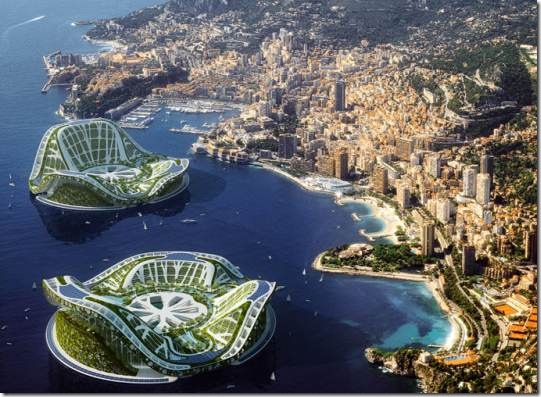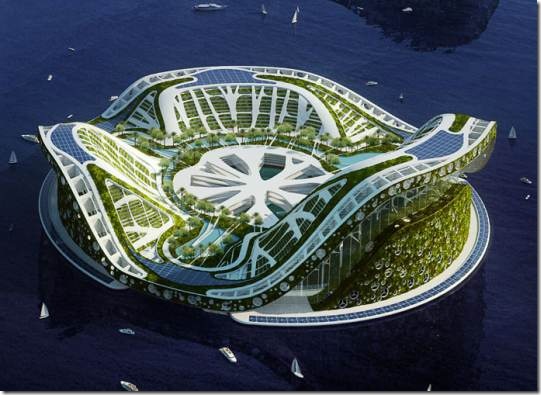The Lilypad, by Belgian architect Vincent Callebaut, is described as "a concept for a completely self-sufficient floating city intended to provide shelter for future climate change refugees."
Forget the dripping wet justification, it's still a pretty neat concept. Each 'lilypad' is "designed to house about 50,000 people in a man-made landscape that includes an artificial lagoon and three 'ridges'" -- producing its own energy through its "titanium dioxide skin" they're intended either to be moored near the coast, or "to float around on the ocean's Gulf Stream."
I can see a few being moored off the coast of Dubai.
More details here.


9 comments:
Nice - puts me in mind of Paolo Soleri's arcologies. Apart from the fact that these are far more easy on the eye.
One thing to appreciate them aesthetically, I'm sure it would be another thing to live in them though.
DenMT
Aye, I hope there is some sort of platform stabilization device. The good thing about land is that it doesn't rise and fall with the waves...
Propulsion as opposed to mere drifting around in the Gulf stream would be nice also. I'd hate to drift into an iceberg or the Galapogos. But then I doubt that solar, tidal and such would provide the energy density required to propel such a monster... Have to switch to nuclear.
Then we have the problem of the waste that 50,000 humans make each day and the amount of water and food they need. Water, I'm guessing could be obtained by desalination.
But the food? Wouldn't that require carbon non neutral farming, sea resupply and such?
Lastly, and I know lefties and anarchists don't like this, what about defense? Fifty thousand people on a floating island is all very well. But there are Pirates out there as the ridiculous farce going on off the coast of Somalian should underline.
I'm hoping the designers have included a few hundred machine guns, cruise missiles and some armor plating alongside that Titanium oxide lining...
Hmmm... I just saw the 'biofiltering lagoons' level (or some such twaddle)... Lot of methane made there, I really wonder if they want that plant at the lowest level. If it blows up there's going to be an awful big hole in the hull...
But the most disturbing aspect is the 'biological kitchens.' Evidently this city is going to attempt to feed itself, but without grazing land for cattle and no processing areas for fish and whales (assuming they are on the menu) - that means the population will have to be vegetarian... I see now why you like it PC :)
Having them moored off cities like the Palms makes sense. But I'm not so sure about having them float around at random.
The nice thing about land is that you doesn't need to expend any effort to keep it intact, and you can grow crops and discharge waste without too much hassle. Fresh water is generally available too.
Floating structures like this, on the other hand, need effort poured into it by the bucket load to construct it, fix it, power it, keep it going, and then there is the whole other issue of food and resources. The ocean is almost completely devoid of resources other than sunlight and fish (and it doesn't have much fish left, thanks to utter lack of property rights out in the big blue). It is a pretty harsh environment to travel through, let alone live permanently on.
So I'm finding it hard to imagine these things being economically viable without major changes in technology (like molecular nanotechnology).
Cool concept though.
There was a brand of guttering that used to tout itself as "titanium dioxide impregnated", presumably because people were supposed to think, "Wow, titanium, that's what the space shuttle is made of," when in fact titanium dioxide was the pigment that made it white.
The sugary white layer in a Jaffa that stops the orange colour leaking into the chocolate is also "titanium dioxide impregnated".
Kind of like how iron (or steel) is what your car is made of but iron oxide (or rust) is what gives it that nice brown colour.
Reminds me of things you sometimes see in Roger Dean paintings.
http://seasteading.org/
Nice but watch those icebergs. It sure ain't warming.
gregster
First let’s question our self why do we need these kinds of "cities"! Isn’t there any place for people to live? Why are we harming the aquatic environment? Don’t we have something called environmental urban planning! Why are we ignoring it! While doing that we are destroying thousand of aqua lives and we are creating an imbalance in the nature. Haven’t we had enough from harming the environment? And I’m not really sure why do we need it from the beginning, is it really worth it...
Don’t we consider if this project is economical to be built or not while we are recovering from the damage happened after the financial crisis!
“Producing its own energy” how can we guarantee that it will indeed!
What about the food and water! Isn’t it a waste of money to transfer the human needs using ships! What about 50,000 human wastes!
It’s nice to have a new different place to live in but it should be economical!
Post a Comment